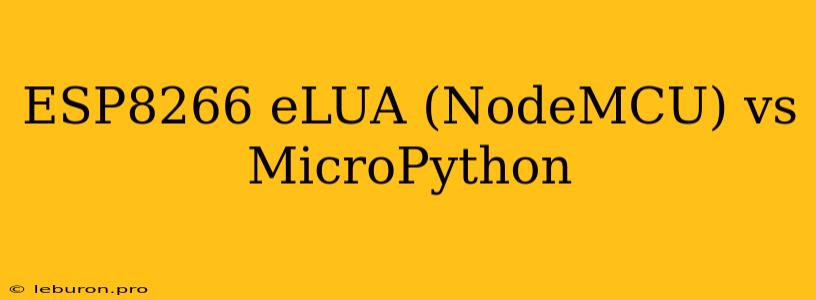The ESP8266, a low-cost and highly capable microcontroller, has gained immense popularity among hobbyists and professionals alike. This powerful chip, often paired with modules like the NodeMCU, provides a versatile platform for diverse IoT and embedded projects. One key decision developers face is choosing between two popular programming languages for the ESP8266: eLUA (often associated with NodeMCU) and MicroPython. Both languages offer distinct advantages and cater to different programming styles, making the choice a crucial one for project success. This article dives deep into the comparison between eLUA and MicroPython, exploring their features, strengths, weaknesses, and ultimately helping you decide which language best aligns with your project needs.
Understanding eLUA and MicroPython
eLUA, also known as Lua in the context of ESP8266, is a lightweight scripting language known for its simplicity and efficiency. It is commonly used with NodeMCU, a development board that integrates the ESP8266 chip with a built-in USB-to-serial converter and other components. eLUA's core strength lies in its lightweight nature, allowing it to run efficiently on resource-constrained devices like the ESP8266.
MicroPython, on the other hand, is a Python dialect specifically designed for microcontrollers. It brings the familiar syntax and structure of Python to the world of embedded programming, making it appealing for developers who already possess Python experience. While MicroPython requires slightly more resources than eLUA, it offers a more robust set of libraries and a more structured programming approach, especially for complex projects.
Comparing Key Features
1. Ease of Use and Learning Curve
eLUA, with its concise syntax and minimal keywords, boasts a relatively gentle learning curve, especially for beginners. Its simple structure and straightforward syntax make it easy to understand and implement basic functionalities. However, mastering advanced concepts like object-oriented programming might require additional effort.
MicroPython, benefiting from its connection to the popular Python language, offers a more familiar and intuitive environment for developers. Its syntax is largely consistent with standard Python, making the transition relatively smooth. This familiarity makes it an excellent choice for developers already comfortable with Python.
2. Library Support
eLUA has a modest collection of libraries, primarily focusing on core functionalities for network communication, GPIO control, and basic data handling. While this might be sufficient for simple projects, developers may need to create custom libraries or find alternative solutions for more complex requirements.
MicroPython shines in its extensive library ecosystem, built upon the vast collection of Python libraries. This access to a diverse range of libraries empowers developers with a wealth of pre-built functionalities, significantly accelerating development and reducing the need for reinventing the wheel.
3. Performance and Memory Usage
eLUA, being a lightweight language, requires minimal resources and performs efficiently on the ESP8266. Its smaller footprint allows for faster execution and efficient memory management, crucial for projects with limited memory resources.
MicroPython, while providing more functionalities and flexibility, has a larger memory footprint compared to eLUA. Its runtime environment and libraries require a bit more memory, potentially impacting performance in resource-constrained applications.
4. Community and Support
eLUA benefits from a moderately active community of developers. While the community provides helpful resources and forums, it might not be as extensive as the Python community, potentially limiting access to support and solutions.
MicroPython enjoys a large and active community of developers and enthusiasts, offering ample resources, forums, and a wealth of online documentation. This strong community fosters a collaborative environment and provides extensive support for both beginners and experienced users.
5. Development Environments
eLUA offers several development environments, including:
- Arduino IDE: Provides a simple and familiar interface for developing and uploading eLUA code to the ESP8266.
- Lua for Windows: A more comprehensive IDE with debugging and code completion features.
- Other IDEs: Developers can use various IDEs for eLUA development, often with plugins or custom configurations.
MicroPython also supports a wide range of development environments, including:
- REPL: A simple interactive command line interface for real-time code execution and testing.
- MicroPython Editor: A dedicated editor for creating and editing MicroPython code.
- Thonny: A user-friendly IDE designed for teaching Python and suitable for MicroPython development.
- Other IDEs: Developers can leverage their preferred IDEs with MicroPython, leveraging the language's compatibility with Python tooling.
Choosing the Right Language
Ultimately, the choice between eLUA and MicroPython depends heavily on your project requirements and your programming experience. Here's a breakdown to help you make the right decision:
Choose eLUA if:
- Your project requires minimal resources: eLUA's lightweight nature makes it ideal for projects with limited memory and processing power.
- You prioritize speed and efficiency: eLUA's simplicity and smaller footprint contribute to faster execution times.
- You are a beginner and want a quick learning curve: eLUA's easy-to-grasp syntax provides a gentle introduction to programming.
Choose MicroPython if:
- Your project requires extensive libraries and features: MicroPython's access to the vast Python library ecosystem makes it suitable for complex projects.
- You have experience with Python: If you're familiar with Python, MicroPython's syntax and structure will feel familiar and comfortable.
- You prioritize a robust and well-supported environment: MicroPython benefits from a large and active community, ensuring ample support and resources.
Conclusion
Both eLUA (with NodeMCU) and MicroPython offer valuable tools for developing projects with the ESP8266. By carefully considering the key factors discussed above, you can select the programming language that best aligns with your project's requirements and your programming preferences. Regardless of your choice, the ESP8266, coupled with either eLUA or MicroPython, empowers you to create innovative and functional IoT projects, unlocking a world of possibilities for embedded programming.
